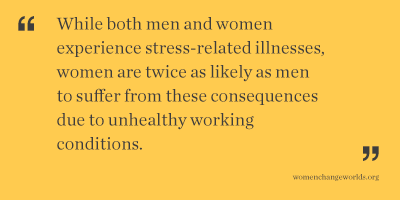 This commentary appears in the Research & Action Report, Spring/Summer 2013 Volume 34 • Number 2 (forthcoming), published by the Wellesley Centers for Women.
This commentary appears in the Research & Action Report, Spring/Summer 2013 Volume 34 • Number 2 (forthcoming), published by the Wellesley Centers for Women.
When we think about employment and health, we often think about high risk jobs and occupational safety. The recent deaths of first responders in Massachusetts and Texas highlight these serious concerns. However, many workers are exposed to unhealthy conditions that, while not lethal, seriously affect their health.
Trends in the new economy of downsizing, job instability, increased workload and longer hours have led to rising concerns about the health consequences of occupational stress. While both men and women experience stress-related illnesses, women are twice as likely as men to suffer from these consequences due to unhealthy working conditions. Jobs with heavy demands and little latitude in managing or meeting demands are particularly stressful, and women of all races, as well as men of color, are more likely to work in jobs with this combination.
 While women’s participation in the work force is quite similar to men’s, the occupations and environments vary greatly. In 2009, 44.6 percent of women worked in just 20 occupations, and most of these occupations were heavily female, such as nurses, teachers, maids and housekeeping cleaners, health aides, and clerks—most of which have higher emotional demands. We need to ensure that researchers are examining the effects of emotional work so that employers can identify and implement ways to reduce the stress of these emotionally demanding jobs. In addition, women in the health and education field experience more nonfatal occupational injuries than would be expected in the general workforce; typical injuries include low-back pain, asthma, and exposure to infectious, biological, or chemical hazards.
While women’s participation in the work force is quite similar to men’s, the occupations and environments vary greatly. In 2009, 44.6 percent of women worked in just 20 occupations, and most of these occupations were heavily female, such as nurses, teachers, maids and housekeeping cleaners, health aides, and clerks—most of which have higher emotional demands. We need to ensure that researchers are examining the effects of emotional work so that employers can identify and implement ways to reduce the stress of these emotionally demanding jobs. In addition, women in the health and education field experience more nonfatal occupational injuries than would be expected in the general workforce; typical injuries include low-back pain, asthma, and exposure to infectious, biological, or chemical hazards.
How can employers and policymakers protect women’s health?
Women need the same protections that men do—standards for workplace health and safety, regular inspections and monitoring of injury rates, and research to develop health and safety practices. However, all too often, women, and women’s occupations and health concerns, have been left out of the funding priorities for research and innovative practices.
But other workplace factors have negative health implications for women employees, too. For example, as women are so concentrated in a select set of occupations, this results in some workplaces where women are not well represented and where they may be less empowered. Research shows that these women are more likely to experience sexual harassment in the workplace—nearly one-quarter of women report having experienced sexual harassment and 58 percent have experienced potentially harassing behaviors at work. We know that sexual harassment affects psychological well-being and increases psychological distress. Since we know that women are at greater risk for sexual harassment, especially in workplaces that have a climate in which workers believe that reports of harassment will not be taken seriously or will not have consequences for the harasser, it’s essential that employers implement and enforce policies that create a climate that promotes equity and respect and does not tolerate sexual harassment.
Additionally, workers—women and men—have families. Their responsibility to care for young children or aging parents does not end when they enter the workplace. However, despite the increasing involvement of men in caregiving, women still bear a greater burden. For example, married mothers take on almost twice the hours of married fathers each week to address family and home responsibilities. Caregiving for children and aging parents also falls more heavily on women’s shoulders.
How does this affect women’s employment and their health?
Work and family balance issues are a health risk for women with children... Read more of Marshall's commentary>>
Nancy Marshall, Ed.D. is an associate director and senior research scientist at the Wellesley Centers for Women at Wellesley College. She leads the Work, Families and Children Team at WCW and studies women and employment, with a focus on working conditions and health and work-family systems, as well as child care policy and early care and education. She authored the chapter, “Employment and Women’s Health,” in M.V. Spiers, P.A. Geller & J.D. Kloss (Eds.), Women’s health psychology (46- 63). New York: John Wiley & Sons.
When you subscribe to the blog, we will send you an e-mail when there are new updates on the site so you wouldn't miss them.
Comments